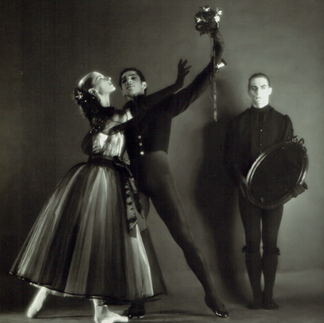NYCB Vol. 15 No. 16 - La Valse
- Lauryn Johnson

- May 21
- 2 min read
Updated: Jun 30
“La Valse may have been the quintessential role of LeClercq, not only for its angular sophistication and doomed half-innocence, which she was superbly equipped to project, but for the eerie parallel between her waltz with Death and her real-life paralysis from polio in 1956. She recalls her feelings about the ballet:
“I just adored it. First of all, I liked to watch in the wings before I came on, watch the other people, waltzing around, with the gloves—they looked so pretty. So I would come out and do the first variations [Eighth Waltz]—the atmosphere was lovely, it was like going to a party. There wasn’t anything terribly hard in the variation, and yet you could work within what you had and make it different.”
—Repertory in Review by Nancy Reynolds
Photos by Roger Wood, 1952
Tanny on La Valse: “I felt that my character put on the [black] jewelry, looked at herself in the mirror and really liked it, was rather eager to plunge into the gloves, then got the coat and thought how fabulous, and began to waltz away—almost mindlessly.”
“Edwin Denby writes of her magical articulation while being dressed by Death; indelible also is her motion of drawing back in fascinated horror as she first views herself in Death’s mirror, clothed in black. ‘The way I remember Tanny’s marvelous gesture of putting on the [long black] gloves was that when she put her hand into the glove she threw up her head at the same time, so that it was kind of immolation, you felt, like diving to destruction. That’s what the atmosphere is about."
(left) Photo by Fred Fehl, 1952
(center) LeClercq and Moncion Photo by George Platt Lynes, 1952
(right) Photo by Fred Fehl, 1952
Writer B.H. Haggin was unimpressed with Ravel’s score for La Valse, and Balachine’s choreography calling them both “sheer nothingness”—he continued, “Except when there were LeClercq’s amazing gifts to stimulate his imagination, and we got her strangely perverse dance with Magallanes, her sinister encounter and dance of death with Moncion (one recalls her death-like face as she begins the dance). What Balanchine did was to bring into operation his powers as a theater artist, and to create with the color of costumes in a play of darkness and light the excitement there would not be in the movement alone.” —B.H. Haggin, The Nation 1951
Footage of Tanaquil LeClercq and Nicholas Magallanes at Jacob’s Pillow.
Piano accompaniment by Dianne Chilgren added to video in 1994
















Comments